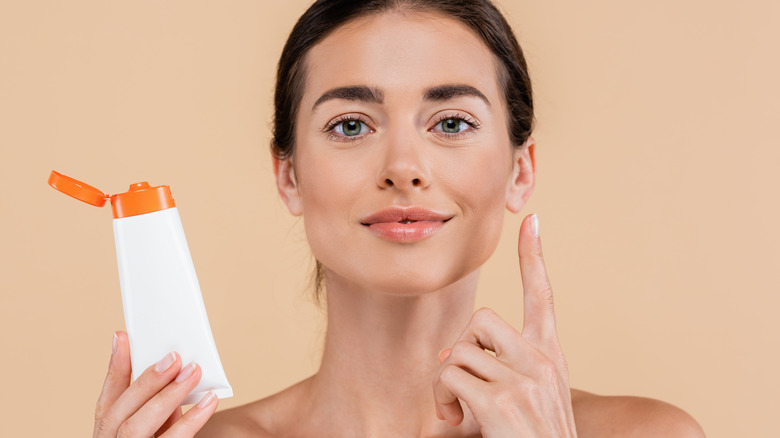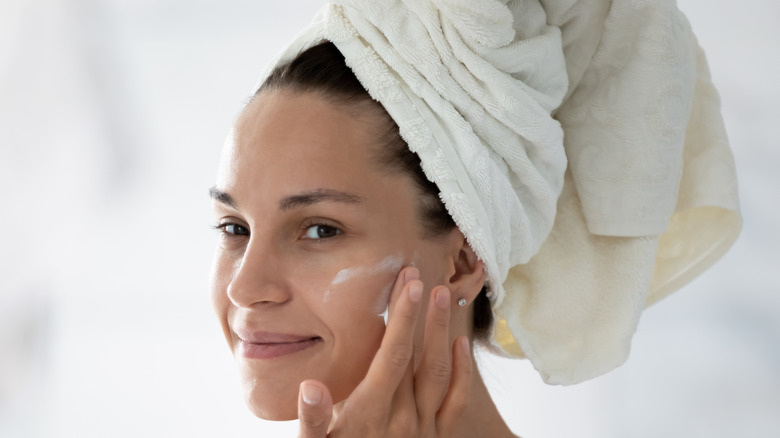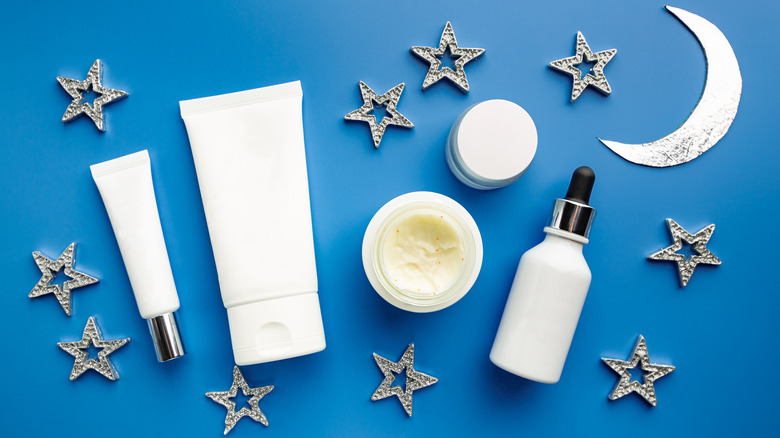The Correct Way To Apply Moisturizing Products For Maximum Benefits
Many of us spend an ample amount of money to get our hands on the latest skincare products. With promises like a youthful glow, fewer wrinkles, and bouncy skin, who can say no to the latest creams, serums, and moisturizers on the market? If you have a growing collection of these products, however, you'll want to make sure you're using them the correct way — and yes, there is a right (and wrong) way to apply them.
Whether you have an extensive nighttime skincare routine, a daily skincare routine pre-makeup application, or both, it can literally pay off to familiarize yourself with the proper way to apply moisturizing products. If you haven't done your research yet, you could be wasting money by using them incorrectly and failing to leverage all of their potential benefits. Generally speaking, moisturizers can really only hydrate your skin if you prep accordingly and time your application. If you don't moisturize regularly, you run the risk of developing dry, cracked skin that itches, flakes, or even bleeds. Depending on outlying factors, such as the temperature of your water when you bathe, you could also be worsening the problem.
Here is everything you need to know about how to apply all of your moisturizing products to reap the maximum benefits. Whether you only rely on lotion or have a full collection of moisturizers, just remember: knowledge is power!
When to apply moisturizer to see the most benefits
To make sure that you're always locking in as much moisture as possible, apply your body moisturizer within five minutes of bathing. "As soon as you get out of the shower, moisture starts getting pulled out of the skin from contact with air," dermatologist Dr. Annie Chiu told Self. The University of Tennessee Medical Center recommends patting your skin dry after bathing — not rubbing or scrubbing it dry — to help you seal in moisture as well.
If you're going to be spending time outdoors in the elements, you'll want to be mindful of everything from wind to ultraviolet (UV) rays. All of these factors can wreak havoc on your skin, especially if you fail to moisturize properly. If you're going outside, you might want to choose a moisturizer that includes sunscreen, for example. Even in the winter, exposed skin is subjected to potential harm from the sun's UV rays.
Many people also forget the importance of moisturizing after shaving or exfoliating. Because you're removing a layer of skin cells, it's important to protect the new skin that is now exposed. Dr. Chiu recommended using a non-comedogenic moisturizer while speaking to Self, especially after shaving — this can prevent pores from clogging and the development of ingrown hairs. Non-comedogenic moisturizers may also stop pimples from arising due to clogged pores.
How to benefit from using moisturizer at night
Whether you're trying to turn back the clock or you simply want to prevent the feeling of taut skin on your face, moisturizing products can help, especially when used as a part of a nighttime skincare routine. However, there is a correct way to apply your moisturizer to reap its benefits.
After using a cleanser to wash your face, pat it dry, and then apply any skin medication you may have. Only after this step should you add your moisturizer. The type of moisturizer you use will likely depend on your skin type. For example, a non-comedogenic moisturizer is ideal for those who struggle with acne. However, a heavier night cream might be better for a person who has dry or cracked skin. "During sleep, the skin's transepidermal water loss is increased, meaning moisture is pulled out of the skin while we snooze," dermatologist Dr. Annie Chiu told Self. "By using a slightly heavier night cream, you are protecting your face from dehydration."
If you use other products as a part of your nighttime skincare routine, your night cream, mask, or nightly moisturizer should always come last. Hydrating toners should be used after any exfoliation, followed by any acid treatments or serums you have. Then, spot treatments can be applied, as well as an eye cream and face oil. Top it all off with your nighttime moisturizer, and you're ready for some shut-eye!


